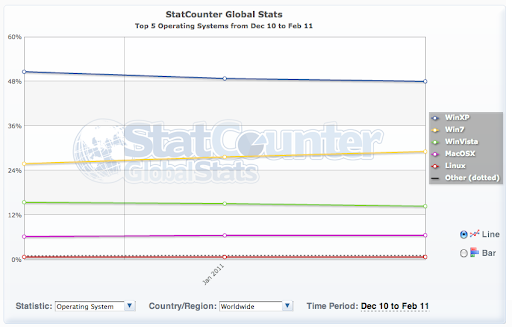Yesterday marked the official release of IE9 from Microsoft.
I’m very curious to see what sort of impact (or lack there of) that this will have on the browser field. The key point is that IE9 does not support Windows XP. That is a big deal for a few different reasons.
Using that numbers available at gs.statcounter.com the worldwide OS breakdown for Dec 10 -> Feb 11 is:

That is Windows XP at 48%, Windows 7 at 29%, and Windows Vista at 14%. That puts total Windows share at 91%, unfortunately only 43% are actually able to upgrade to IE9. More than half of the current Windows users have no way to upgrade to IE9.
Next up is the IE6 issue, a browser that everyone loves to hate. Even Microsoft doesn’t want people to use it anymore. The release of IE9 does absolutely nothing to reduce the number of IE6 users out there. Why? Because the only versions of Windows that IE9 supports, Vista and 7, never shipped with IE6. Windows Vista shipped with IE7 and Windows 7 shipped with IE8.

IE6 is listed as the 5th most popular browser version is use. Starting from the top: IE8 at 30%, Firefox 3.6 at 25%, Chrome 9 at 12%, IE7 at 10%, and IE6 at 4%.
If we want to reduce IE6 usage in the world the focus has to be on getting people to switch to a completely different browser. Pushing IE7 or IE8 as options for those Windows XP users isn’t good either, since neither of them support TLS server name identification. For Windows XP users you are best served by moving to either Google Chrome or Mozilla Firefox.